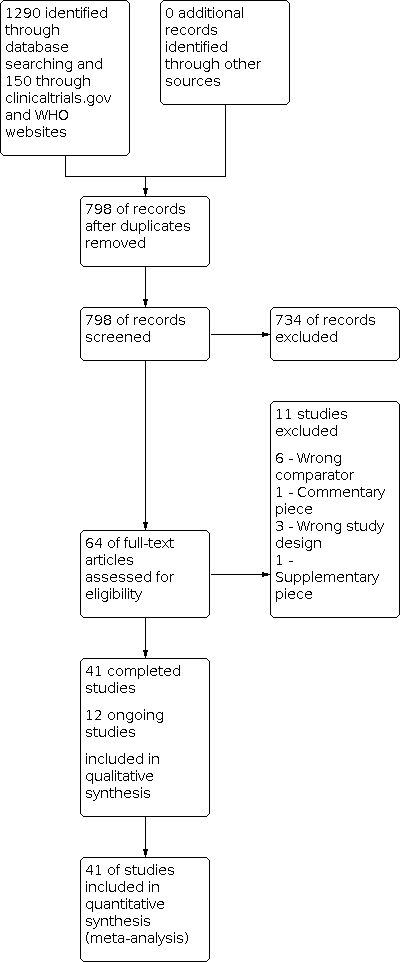| 1.1 Pain at different postoperative days (visual analogue scale 0 to 10, lower is better) Show forest plot | 14 | | Mean Difference (IV, Random, 95% CI) | Subtotals only |
|
| 1.1.1 Pain: day 1 | 8 | 577 | Mean Difference (IV, Random, 95% CI) | 1.25 [0.32, 2.19] |
| 1.1.2 Pain: day 2 | 6 | 394 | Mean Difference (IV, Random, 95% CI) | 0.37 [‐0.03, 0.76] |
| 1.1.3 Pain: day 3 | 10 | 807 | Mean Difference (IV, Random, 95% CI) | 0.78 [0.34, 1.23] |
| 1.1.4 Pain: week 2 | 6 | 562 | Mean Difference (IV, Random, 95% CI) | 0.32 [0.12, 0.53] |
| 1.1.5 Pain: week 6 | 6 | 637 | Mean Difference (IV, Random, 95% CI) | 0.38 [‐0.48, 1.23] |
| 1.2 Function: patient‐reported knee function at 3 months (scale 0 to 100, higher is better) Show forest plot | 4 | 425 | Std. Mean Difference (IV, Random, 95% CI) | ‐0.64 [‐1.52, 0.25] |
|
| 1.3 Function: patient‐reported knee function at 12 months (scale 0 to 100, higher is better) Show forest plot | 5 | 611 | Std. Mean Difference (IV, Random, 95% CI) | ‐0.06 [‐0.22, 0.10] |
|
| 1.4 Global assessment of success: participant‐reported satisfaction at 3 months (based on number of participants, higher is better) Show forest plot | 1 | 100 | Risk Ratio (M‐H, Random, 95% CI) | 1.02 [0.92, 1.14] |
|
| 1.5 Global assessment of success: participant‐reported satisfaction at 6 months (based on number of participants, higher is better) Show forest plot | 1 | 100 | Risk Ratio (M‐H, Random, 95% CI) | 1.00 [0.91, 1.10] |
|
| 1.6 Health‐related quality of life: SF‐12 mental component at 6 weeks (0 to 100, higher is better) Show forest plot | 1 | 199 | Mean Difference (IV, Random, 95% CI) | 2.58 [‐0.09, 5.25] |
|
| 1.7 Health‐related quality of life: SF‐12 mental component at 6 months (0 to 100, higher is better) Show forest plot | 1 | 199 | Mean Difference (IV, Random, 95% CI) | 1.53 [‐0.85, 3.91] |
|
| 1.8 Serious adverse events Show forest plot | 21 | 1799 | Risk Ratio (M‐H, Random, 95% CI) | 1.73 [1.10, 2.73] |
|
| 1.9 Serious adverse event: venous thromboembolic event (VTE) Show forest plot | 17 | 1575 | Risk Ratio (M‐H, Random, 95% CI) | 1.95 [0.99, 3.82] |
|
| 1.10 Serious adverse event: deep vein thrombosis (DVT) Show forest plot | 17 | 1602 | Risk Ratio (M‐H, Random, 95% CI) | 2.05 [1.35, 3.13] |
|
| 1.10.1 Symptomatic DVT | 16 | 1499 | Risk Ratio (M‐H, Random, 95% CI) | 1.83 [0.92, 3.65] |
| 1.10.2 Asymptomatic DVT | 1 | 103 | Risk Ratio (M‐H, Random, 95% CI) | 2.20 [1.29, 3.74] |
| 1.11 Serious adverse event: pulmonary embolism (PE) Show forest plot | 5 | 416 | Risk Ratio (M‐H, Random, 95% CI) | 4.51 [0.49, 41.81] |
|
| 1.12 Serious adverse event: infection Show forest plot | 9 | 846 | Risk Ratio (M‐H, Random, 95% CI) | 2.72 [1.15, 6.42] |
|
| 1.13 Serious adverse event: re‐operation Show forest plot | 3 | 157 | Risk Ratio (M‐H, Random, 95% CI) | 1.63 [0.61, 4.34] |
|
| 1.14 Survival of the implant: risk of revision up to 2 years Show forest plot | 3 | 214 | Risk Ratio (M‐H, Random, 95% CI) | 1.44 [0.23, 8.92] |
|
| 1.15 Blood loss: postoperative transfusion risk (lower is better) Show forest plot | 18 | 1286 | Risk Ratio (M‐H, Random, 95% CI) | 1.20 [0.86, 1.67] |
|
| 1.16 Blood loss: intraoperative (mL, lower is better) Show forest plot | 15 | 1187 | Mean Difference (IV, Random, 95% CI) | ‐147.05 [‐190.97, ‐103.12] |
|
| 1.17 Blood loss: postoperative (mL, lower is better) Show forest plot | 12 | 776 | Mean Difference (IV, Random, 95% CI) | 57.72 [13.58, 101.87] |
|
| 1.18 Blood loss: overall blood loss (mL, lower is better) Show forest plot | 18 | 1500 | Mean Difference (IV, Random, 95% CI) | 8.61 [‐83.76, 100.97] |
|
| 1.19 Blood loss: change in haemoglobin (g/dL, lower is better) Show forest plot | 9 | 713 | Mean Difference (IV, Random, 95% CI) | ‐0.14 [‐0.48, 0.19] |
|
| 1.20 Economic: length of hospital stay (days, lower is better) Show forest plot | 12 | 995 | Mean Difference (IV, Random, 95% CI) | 0.34 [0.03, 0.64] |
|
| 1.21 Economic: duration of surgery (minutes, lower is better) Show forest plot | 27 | 2070 | Mean Difference (IV, Random, 95% CI) | ‐3.70 [‐5.53, ‐1.87] |
|
| 1.22 Implant stability: maximum total point motion at 8 weeks (mm, lower is better) Show forest plot | 2 | 130 | Mean Difference (IV, Random, 95% CI) | ‐0.06 [‐0.13, 0.01] |
|
| 1.23 Implant stability: maximum total point motion at 1 year (mm, lower is better) Show forest plot | 2 | 130 | Mean Difference (IV, Random, 95% CI) | 0.05 [‐0.09, 0.18] |
|
| 1.24 Implant stability: maximum total point motion at 2 years (mm, lower is better) Show forest plot | 2 | 130 | Mean Difference (IV, Random, 95% CI) | 0.06 [‐0.08, 0.19] |
|





























